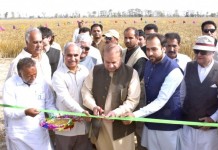LAHORE: The diabetes prevalence survey of Pakistan has revealed staggering 16.98 percent prevalence of diabetes, as 35.5 million people among adult population were found diabetic in Pakistan.
The latest data gathered in 2017 belied old figures of 6.56 percent of diabetes prevalence, affecting 7.6 million people in Pakistan, which was mentioned in the International Diabetes Federation 2017 Atlas.
Diabetes prevalence also tripled under the fresh survey conducted by Hayatabad Medical Complex, Peshawar, in collaboration with the Pakistan Endocrine Society and Institute of Public Health and Social Sciences, Khyber Medical College University, as well as the University of Manchester and University of Glasgow.
“One in every six persons is a diabetic in Pakistan as a whopping 9.04 percent of new diabetes mellitus (without them being knowing about their disease) were added in the fresh findings of the diabetes prevalence in Pakistan,” said Hayatabad Medical Complex Endocrinologist consultant Prof AH Amir, while unveiling the latest survey findings during his presentation on “Prevalence of Diabetes – Past, Present and Future; How are we doing?” at the PES-SAFES Summit 2017 titled “Together for Endocrinology”, organised by Pakistan Endocrinology Society – South Asian Federation of Endocrinology Societies (PES-SAFES).
Dr A H Amir informed that, based on census results of 2017 for adult population, approximately 21.9 million were suffering from diabetes mellitus (DM), which suggested a ratio of 1:7 for diabetes prevalence among population aged 20 or above. Out of total prevalence in the latest survey, at least 17.85 percent female population was affected and 16.22 male population was suffering from the disease.
He informed that Diabetes Prevalence Survey of Pakistan (DPSP) was planned in February 2017 and started in April this year, and was completed as recently as in November 2017 despite one-month break during Ramadan.
One lead epidemiologist headed 3 research teams having 3 members each to conduct the research.
The survey was conducted among a total of 18,856 eligible screened subjects out of initial sample size of 22,100 patients, from 378 clusters including 216 in rural areas and 162 in urban areas across Pakistan.
The male subjects included 10,100 (53 percent) and female subjects 8,756 (47 percent) from Sindh, interior Sindh, Punjab, Southern Punjab, Balochistan, Khyber Pakhtunkhwa (central, southern and northern parts), Islamabad/Rawalpindi, Azad Jammu Kashmir-Gilgit-Baltistan (AJK-GB) and Federally Administered Tribal Areas (FATA).
He explained the methods included multi-staged random cluster sampling as each cluster comprised 50 households with face-to-face interviews to collect basic demographic data.
Published in Daily Times, November 26th 2017.













